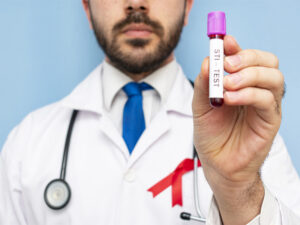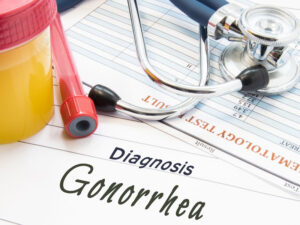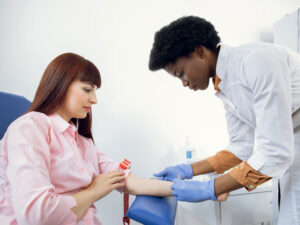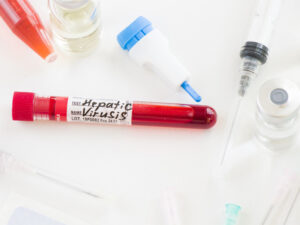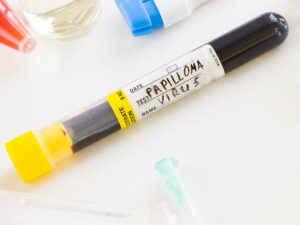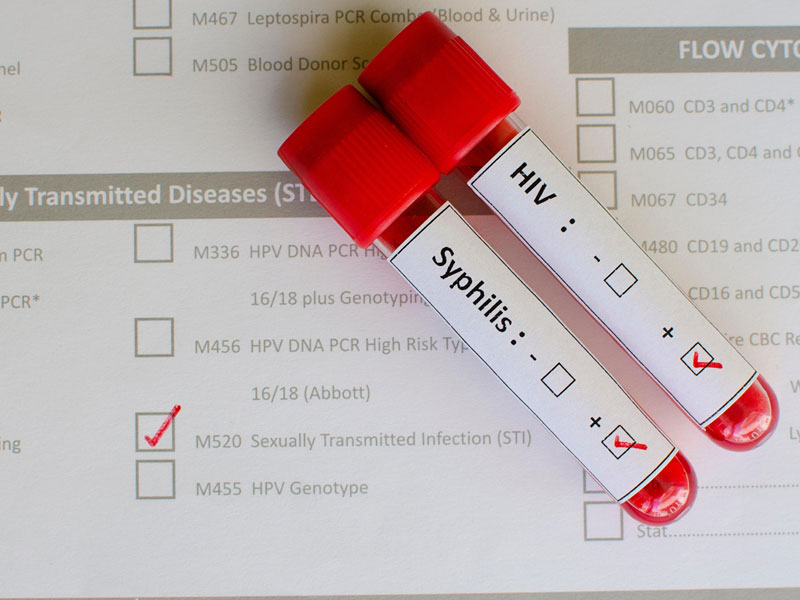
We’re looking at the whole topic of blood tests for STDs because, after colds, sexually transmitted diseases – STDs – are the second most common infections in the United States and Canada. Over one million people get infected every year.
These infections are often silent in their onset and devastating in their consequences. But they pose significant challenges to disease control – alongside stigma, isolation, and even social inequities.
But there’s a way to prevent and control STDs – with early detection through regular blood testing.
While STD detection methods vary, blood testing stands as the main ally in the fight against these infections, enabling timely intervention, treatment, prevention of further transmission, and disease control.
Today’s blog is all about STD prevention and detection. Dive into our comprehensive guide to blood tests for STDs to learn about the different sexually transmitted threats and what you can do to protect yourself and your partners.
Table of Contents
What Are STDs And How Do They Differ from STIs?
Which STDs Can Be Detected By Blood Tests?
What Does a Full STD Blood Panel Consist of?
How Accurate Are Blood Tests for STDs
Will a Gynecologist Test for STDs?
Getting Tested Regularly: Importance and Recommendations
Processing Time for STD Blood Tests for Both Positive and Negative Results
Positive Blood Test for STDs: Now, What?
What Are STDs And How Do They Differ from STIs?
Sexually transmitted diseases (STDs) and sexually transmitted infections (STIs) are related terms that refer to conditions caused by pathogens. These pathogens are bacteria, viruses, parasites, or fungi transmitted through sexual contact, including vaginal, anal, or oral sex.
Sexually Transmitted Infections STIs refer to infections that may or may not result in symptoms and, without STI testing, may develop into an STD.
Many STIs, especially in their early stages, are asymptomatic or cause mild symptoms that go unnoticed. That’s why regular STI testing is essential to detect and treat infections early, preventing them from progressing into a disease.
Sexually Transmitted Diseases STDs, on the other hand, are infections that have progressed to the point of causing symptoms or clinical manifestations.
Do Blood Tests Show STDs?
Blood tests can show certain STDs, but not all. If you’re concerned about your sexual health, please consult with your healthcare provider for guidance on appropriate STI testing based on your specific circumstances. Keep an open dialogue with your doctor, sharing relevant information and asking questions.
Which STDs Can Be Detected By Blood Tests?
As mentioned, blood tests remain essential for the detection and prevention of some STDs because they
- enable early diagnosis even without symptoms,
- facilitate partner notification, and
- inform public health efforts.
However, not all STDs will show up through a simple blood draw. Some infections, such as chlamydia and gonorrhea, typically require specific STI testing, like swab tests of genital, rectal, or throat samples or urine test.
So, for reference, here is a list of the most common STDs that a blood sample can detect:
Syphilis
Caused by bacteria, syphilis progresses through several stages, each with its own symptoms. If left untreated, syphilis can cause serious health problems, including damage to your brain, heart, and other organs.
HIV/AIDS
The Human Immunodeficiency Virus (HIV) attacks your immune system, specifically targeting CD4 cells, which are crucial for fighting off infections.
Without treatment, HIV can lead to acquired immunodeficiency syndrome (AIDS) – a condition characterized by a weakened immune system and increased susceptibility to opportunistic infections and certain cancers.
Herpes Simplex Virus (HSV)
HSV exists in two main types: HSV-1, which typically causes oral herpes (cold sores), and HSV-2, which usually causes genital herpes. Both types can infect the mouth and genitals.
While there is no cure for oral or genital herpes, antiviral medications can help manage outbreaks and reduce transmission risk.
Hepatitis B and C
Hepatitis B and hepatitis C are viral infections that primarily affect the liver. They usually result from sexual contact or sharing needles – or perhaps transmit from mother to child during childbirth. Chronic hepatitis C and B infections can lead to liver damage, cirrhosis, and an increased risk of liver cancer.
Depending on your age, gender, or risk factors, your healthcare provider may recommend a full STD blood panel. Let’s check what you should expect from it.
What Does a Full STD Blood Panel Consist of?
A full STD blood panel typically consists of a comprehensive set of tests designed to detect a range of sexually transmitted infections (STIs) through blood samples. This STI testing can detect both active infections and past exposures to a sexually transmitted disease.
The specific STI testing in a full STD blood panel may vary depending on your condition, healthcare provider preferences, and available testing facilities. However, a typical full STD blood panel may include the following tests:
- HIV Antibody Test
- Syphilis Antibody Test
- Hepatitis B Surface Antigen (HBsAg) Test
- Hepatitis B Core Antibody (anti-HBc) Test
- Hepatitis C Antibody Test
- Herpes Simplex Virus (HSV) Antibody Test
How Accurate Are Blood Tests for STDs?
Blood STI testing can be highly accurate when used appropriately and interpreted with other clinical information.
However, it’s essential to consider the limitations of STI testing, including the potential for false-negative and false-positive results. You then follow up with confirmatory testing or additional diagnostic evaluations, as needed.
The timing of STI testing relative to exposure and infection can also affect the accuracy of results. Therefore, you should always consult your healthcare providers for guidance on appropriate testing methods and timing based on your specific circumstances.
What STDs Cannot Be Tested for By Blood?
Now that you know what STDs can be detected through a blood sample, let’s check the ones that cannot.
Understanding this difference is paramount to empowering you with information for your next testing. So, here’s a list of STDs that blood tests cannot detect, followed by the test you should take for them:
Human Papillomavirus (HPV)
Human Papillomavirus HPV is the most common sexually transmitted infection worldwide.
It comprises a group of viruses, some of which can cause genital warts. Others may even link to some cancers, including cervical, anal, and oropharyngeal cancer. Vaccination against HPV is available, and we recommend it for teenagers and young adults.
HPV Test
HPV testing typically occurs alongside Pap smear screening as part of routine cervical cancer screening guidelines.
Positive HPV test results may indicate the presence of an HPV infection. But you may need further evaluation – such as colposcopy and biopsy – to assess the risk of cervical cancer and determine the appropriate management.
We often get asked: Will a Pap smear test for STDs if a blood test will not?
No. While this is an important screening tool for cervical cancer, it’s not a comprehensive STD screening test.
Chlamydia
Caused by bacteria, chlamydia is one of the most common STDs worldwide. It can infect both men and women and is often asymptomatic. If left untreated, chlamydia can lead to severe complications such as pelvic inflammatory disease (PID) in women and epididymitis in men.
Gonorrhea
Gonorrhea is another bacterial infection that can infect the genitals, rectum, and throat. Untreated gonorrhea can result in severe complications, including infertility and an increased risk of HIV transmission.
Trichomoniasis
Caused by a parasite, trichomoniasis can infect the genital tract in both men and women. While it often causes symptoms such as vaginal discharge and itching in women, it may be asymptomatic in men. Trichomoniasis is usually treated with antibiotics.
What Tests Can Detect Chlamydia, Gonorrhea, and Trichomoniasis?
Chlamydia, gonorrhea, and trichomoniasis are typically detected through laboratory testing of genital, rectal, or throat samples using a swab or a urine test.
The most common test to diagnose these STDs is a nucleic acid amplification test (NAAT). NAATs are highly sensitive and specific tests that detect the genetic material (DNA) of the bacteria or parasite that causes the infections.
Will a Gynecologist Test for STDs?
Yes, gynecologists commonly offer testing for sexually transmitted diseases (STDs) as part of their routine services for women’s reproductive health. During your gynecological visit, your gynecologist may offer STD testing based on your risk factors, sexual history, symptoms, and screening guidelines.
It’s important to communicate openly and honestly with your gynecologist about your sexual history and any concerns you may have regarding STDs. This information helps ensure you receive appropriate testing, treatment, and preventive care tailored to your needs.
Here’s what you can expect regarding STD testing during your gynecological visit:
- Discussion of sexual history
- Offer of STD testing based on your sexual history and risk factors
- Sample collection
- Testing and follow-up
- Education and prevention
Getting Tested Regularly: Importance and Recommendations
Regular STD testing is essential for disease control.
The Centers for Disease Control and Prevention (CDC) recommends routine STD screening based on individual risk factors. This helps prevent the spread of STDs, ensures early detection, and facilitates prompt treatment.
The CDC provides guidelines for STD tests based on individual risk factors, including sexual behaviors, age, and medical history. These recommendations help healthcare providers determine the appropriate frequency and type of STD testing for their patients.
Here are some CDC recommendations:
Annual STI Screening for Certain Groups
The CDC recommends annual screening for chlamydia and gonorrhea for sexually active women aged 25 and younger, as well as older women with risk factors such as having multiple sexual partners or a history of STDs.
More Frequent Screening for High-Risk Individuals
Individuals with higher risk factors, such as men who have sex with men (MSM) and individuals with multiple sexual partners. These groups may benefit from more frequent STD screening, such as every 3 to 6 months.
Screening During Pregnancy
Pregnant women should be screened for syphilis, HIV, hepatitis B, and have a chlamydia test at their first prenatal visit, with additional testing as needed based on individual risk factors.
Processing Time for STD Blood Tests for Both Positive and Negative Results
When you do a blood test for STDs, it’s not uncommon to have concerns or misconceptions about delays in receiving results. These delays are usually due to additional testing or verification processes. So, here are some clarifications:
Delay in Results:
If you do not receive your STD test results within the expected timeframe, don’t panic. This delay does not necessarily indicate a positive result.
Delays in receiving test results can occur for reasons unrelated to the test outcome, such as laboratory processing times, administrative issues, or high testing volumes.
Additional Testing:
In some cases, results from positive STD tests may require additional confirmatory testing or verification to ensure accuracy. For example, if an initial screening test produces a positive result, follow-up STD testing may be needed to confirm the diagnosis and rule out false positives.
While additional STD testing may prolong the time it takes to receive results, it’s necessary to ensure the reliability of the diagnosis.
False Positives:
False-positive results – where an STD blood test incorrectly indicates the presence of a sexually transmitted disease – can occur with any diagnostic test, including STD tests. Additional testing or verification processes help reduce the risk of false positives and ensure that you receive an accurate diagnosis and appropriate treatment.
Communication with Healthcare Providers:
If you have concerns about delays in receiving test results or the need for additional testing, you should communicate openly with your doctor. They can provide information about the testing process to allay your worry.
Positive Blood Test for STDs: Now, What?
Receiving positive test results from STD testing can evoke a range of emotions. No one wants positive test results from STD tests, whether blood draw, swab tests, or urine sample.
However, it’s essential to prioritize self-care, seek support, and engage in open and honest communication with your sexual partners.
With appropriate medical treatment, emotional support, and preventive measures, you can navigate a positive STD test result and move forward in maintaining your sexual health and well-being.
Do STIs Go Away?
If you received a positive result for a sexually transmitted infection, this is probably the first question that came to your mind.
The general rule is that the earlier you get diagnosed and receive treatment, the better the outcomes. Typically, the outcome of an STI depends on many factors, including the type of infection, your immune response, and whether you have treatment.
While some STIs can go away on their own or with treatment, others may become chronic infections that require long-term management. For this reason, seeking medical care promptly is paramount if you suspect you have an STI. Early detection and treatment can help prevent complications and reduce the risk of transmission to your sexual partners.
Access a Blood Test for STDs with Stella Mattina
Now you know more about STIs and blood tests for STDs, why not trust Stella Mattina’s specialist women’s healthcare providers to assess, diagnose, manage, and treat possible STDs? There’s nothing we haven’t seen or heard before, and we’re compassionate and non-judgmental in our care for you.
Let’s talk today.
Schedule your appointment today!
Dr. Krum is currently in practice in Arlington, TX. He received his undergraduate degree at Texas A&M University, then attended UTMB Galveston for medical school, finishing in 1986, completing his residency there in 1990. Providing a full range of obstetrical and gynecological care, he specializes in the treatment of endometriosis and robotic surgery. He arranges his schedule so that same-day appointments are usually available.
